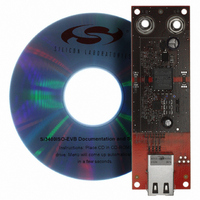SI3400ISO-EVB Silicon Laboratories Inc, SI3400ISO-EVB Datasheet - Page 13

SI3400ISO-EVB
Manufacturer Part Number
SI3400ISO-EVB
Description
BOARD EVAL ISOLATED FOR SI3400
Manufacturer
Silicon Laboratories Inc
Type
PWM Controllersr
Datasheet
1.SI3400-E1-GM.pdf
(20 pages)
Specifications of SI3400ISO-EVB
Mfg Application Notes
SI3400/01 High Power AppNote Si3400/1 PoE PD Controllers AppNote
Main Purpose
Special Purpose DC/DC, Power Over Ethernet
Outputs And Type
1, Isolated
Voltage - Output
5V
Voltage - Input
44 ~ 57V
Regulator Topology
Flyback
Frequency - Switching
350kHz
Board Type
Fully Populated
Utilized Ic / Part
Si3400
Input Voltage
5 V
Output Voltage
3.3 V
Interface Type
Ethernet
Maximum Operating Temperature
+ 85 C
Minimum Operating Temperature
- 40 C
Product
Power Management Modules
For Use With/related Products
Si3400
Lead Free Status / RoHS Status
Contains lead / RoHS non-compliant
Current - Output
-
Power - Output
-
Lead Free Status / Rohs Status
Lead free / RoHS Compliant
Other names
336-1353
SI3400ISO-EVB
SI3400ISO-EVB
3.2.6. Power Loss Indicator
A situation can occur in which power is lost at the input
of the diode bridge and the hotswap controller does not
detect the fault due to the VPOS to VNEG capacitor
maintaining the voltage. In such a situation, the PD can
remain operational for hundreds of microseconds
despite the PSE having removed the line voltage. If it is
recognized early enough, the time from power loss to
power failure can provide valuable time to gracefully
shut down an application.
Due to integration of the diode bridges, the Si3400 and
Si3401 are able to instantaneously detect the removal
of the line voltage and provide that early warning signal
to the PD application. The PLOSS pin is an open drain
output that pulls up to VPOS when a line voltage greater
than 27 V is applied. When the line voltage falls below
27 V, the output becomes high-impedance, allowing an
external pull-down resistor to change the logic state of
PLOSS. The benefit of this indicator is that the powered
device may include a microcontroller that can quickly
save its memory or operational state before draining the
supply capacitors and powering itself down. This feature
can help improve overall manageability in applications,
such as wireless access points.
3.3. Switching Regulator
Power over Ethernet (PoE) applications fall into two
broad categories, isolated and non-isolated. Non-
isolated systems can be used when the powered device
is self-contained and does not provide external
conductors to the user or another application. Non-
isolated applications include wireless access points and
SSFT
VREF
IABS
FB
ITC
ERROR
AMPLIFIER
OSCILLATOR
STARTUP & BIAS
SWITCHER
HSO
Figure 4. Switcher Block Diagram
EROUT
VDD
MODULATOR
Rev. 0.9
ISOSSFT
VPOSF
PULSE-
WIDTH
security cameras. In these applications, there is no
explicit need for dc isolation between the switching
regulator output and the hotswap interface. An isolated
system must be used when the powered device
interfaces with other self-powered equipment or has
external conductors accessible to the user or other
applications. For proper operation, the regulated output
supply of the switching regulator must not have a dc
electrical path to the hotswap interface or switching
regulator primary side. Isolated applications include
point-of-sale terminals where the user can touch the
grounded metal chassis.
The application determines the converter topology. An
isolated application will require a flyback transformer-
based
application can use an inductor-based buck converter
topology. In the isolated case, dc isolation is achieved
through a transformer in the forward path and a voltage
reference plus opto-isolator in the feedback path. The
application circuit shown in Figure 2 is an example of
such a topology. The non-isolated application in
Figure 1 makes use of a single inductor as the energy
conversion element, and the feedback signal is directly
supplied into the internal error amplifier. As can be seen
from the application circuits, the isolated topology has
an increased number of components, thus increasing
the bill of materials (BOM) and system footprint.
To optimize cost and ease implementation, each
application should be evaluated for its isolated or non-
isolated requirements.
VPOSS
VSSA
switching
SWITCH
DRIVE
topology
Si3400/Si3401
VSS1
VSS2
while
SWO
a
non-isolated
13










